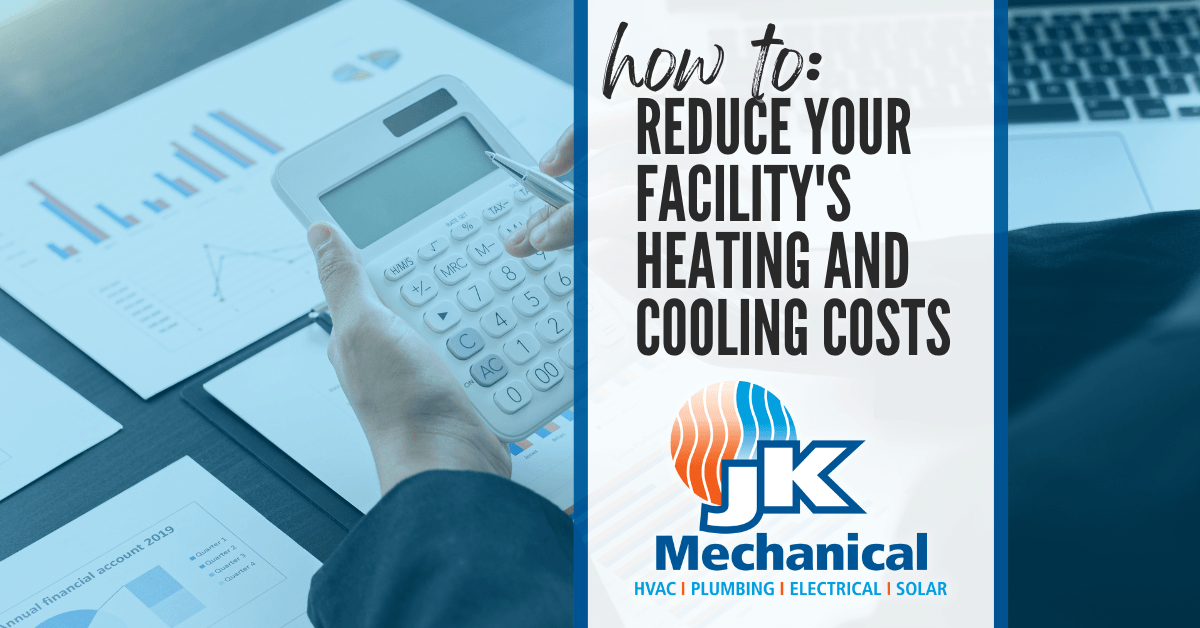How to Reduce Your Facility’s Heating & Cooling Costs
According to Energy.gov, the average commercial facility spends 30% of its total energy consumption on heating, cooling, and ventilation. For less efficient buildings or facilities with specialty conditioning needs, that figure can be even higher. At JK Mechanical, one of the things we’re known for is delivering smart, efficient HVAC solutions without compromising on comfort. Keep reading to learn more about how your facility (or home, or church) can reduce your HVAC operating costs while still keepings things comfortable:
Schedule Regular Professional Maintenance
We’ve said this one before, but it bears repeating: scheduling regular, professional maintenance on your HVAC system is one of the best ways to help your unit work more efficiently, more reliably, avoid breakdowns, and even extend the life of your system. According to a study from the National Center for Energy Management, professional, regular maintenance can reduce HVAC energy costs by at an average of 15 – 20 percent per year! Plus, regular maintenance appointments give your HVAC professional the opportunity to identify potential problems before they turn into a large and costly breakdown, saving you further in the long run.
Choose Quality Equipment
Depending on the age of your equipment and the needs of your facility, choosing the right type, size, and efficiency of your HVAC system makes a lasting, significant difference in the efficiency and comfort of your facility. While a higher-efficiency or more customized system might be a higher initial investment, the savings on operating expenses can significantly reduce the payback time and ongoing operating costs. According to Energy.gov, Energy Star certified heating and cooling equipment, when properly installed, can yield annual energy bill savings of 10-30%.
The type of HVAC system you install can have an impact on operating costs as well. Water Source heat pumps and geothermal heat pumps for example, can be much more efficient than many electric-only or combustion-based heating system (not to mention better for the environment!). In some cases, adding supplemental conditioning with mini-splits or ventilation technology such as a MAU can improve the efficiency of the space. Every application is different, which is why your trained JK consultant can help you evaluate your equipment options to make the decision that works best for your facility, your budget, and the building occupants.
Bonus tip: Really serious about cutting your facility’s carbon footprint and electric costs? EnergySage market data suggests that the average commercial property owner in the U.S. can reduce overall energy costs by 75 percent by going solar. We know this firsthand: at the JK Mechanical office, we are better than net zero. On a 12-month basis, our rooftop solar array produces an average of 10,000 kWh more per year than we consume with little to no maintenance needs, providing a positive financial (and environmental!) benefit even before other solar incentives such as utility/tax rebates are considered.
Evaluate Your Controls
Thermostat and control technology has advanced significantly from the days of a simple knob on a radiator or dial on the wall. As a rule in HVAC, better control means better savings. The more your facility can customize your comfort needs with reliable control technology, the less likely you are to pay for energy use that isn’t needed or wanted, all while improving occupant comfort and satisfaction. In smaller applications such as a single-family home or an individual unit or office, this can often be achieved with a smart or programmable thermostat. According to Energy Star, the average homeowner can save up to 23% on their heating and cooling costs just by switching to a smart thermostat. In larger applications such as large residential homes, small-to-large commercial facilities, or even multi-building campuses, utilizing custom Advanced Controls is a smarter, more efficient, and more centralized way to get the job done.
Don’t Forget About Ventilation
As building envelope tightness and increased efficiency standards become more prevalent in the construction industry and considering the long-term effects of the COVID-19 pandemic on Indoor Air Quality Concerns, maintaining safe ventilation standards is an important part of the HVAC design for any building. Depending on the needs of your facility, your HVAC technician or consultant may recommend equipment such as an ERV, or “Energy Recovery Ventilator,” which recovers energy from the airstream discharged from the building and transfers this energy to the incoming air used for ventilation. In other words, an ERV can provide the benefits of fresh air while still offering filtration and control. Our commercial team also frequently works with Makeup Air Units, or MAUs, which are equipment specifically designed to provide needed ventilation while also conditioning the air before introducing it to the building, thus providing the benefits of fresh air while also improving building efficiency. In both cases, you get reduced operating costs AND safer indoor air. Win/win.
At JK Mechanical, we understand that there are hundreds if not thousands of decisions that go facility design, construction, and maintenance. Talk to our service team to learn more about indoor air quality and how we can help.


